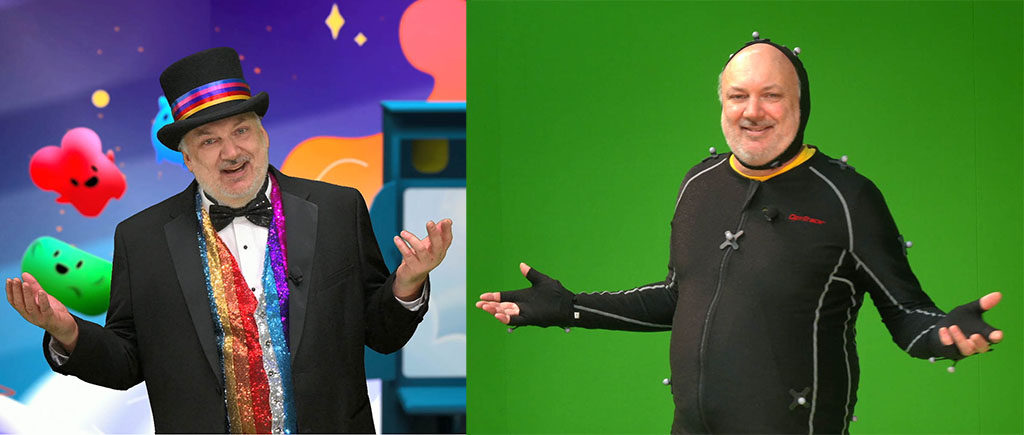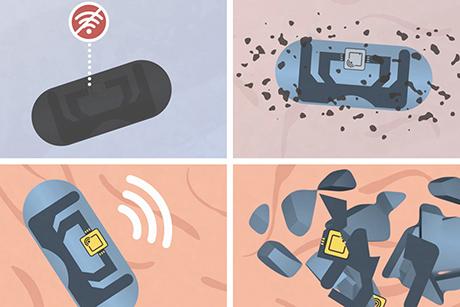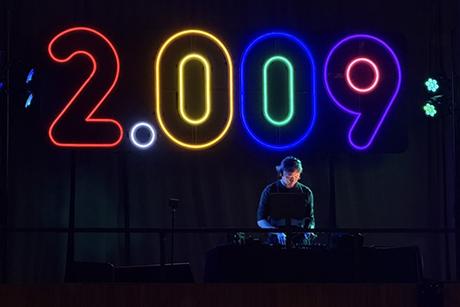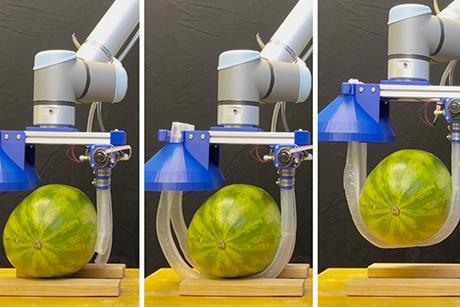Students present product prototypes inspired by kindness
On the evening of Dec. 7, six teams of mechanical engineering students presented the product prototypes they developed this semester in class 2.s009 (Explorations in Product Design), a special version of class 2.009 (Product Engineering Processes). For many MIT seniors, their entire undergraduate experience culminates in these final presentations. But this year, there were no guarantees.
“I spent three years wondering if 2.009 would measure up to the expectations I had. And then the pandemic hit, and essentially my hopes were dashed for the quintessential ‘009’ experience,” says Isy Osubor, a senior studying mechanical engineering.
Thanks to the efforts of course instructor Professor David Wallace and a massive team of staff, students like Osubor weren’t left disappointed.
“Even with all the restrictions in place, this class has managed to blow every single expectation straight out of the water,” said Osubor during Monday’s webcast. “Professor Wallace, because of all your efforts we are able to leave this class with amazing memories, lasting friendships, and honestly as better people and thinkers.”
In a typical semester of 2.009 (Product Engineering Processes), teams of students present their products in front of a sold-out crowd in Kresge Auditorium. Faculty, students, alumni, and staff from across the MIT community come together in a colorful celebration each year. Rows of students wave pompoms and cheer on their teammates as a live band sings pun-filled covers of popular songs.
By late spring, it became clear that the class would need to look very different this year. Wallace, who is in his 25th year of teaching the class, spent the summer working with a small army of dedicated teaching staff, administrative staff, teaching assistants, and the team in MIT’s Pappalardo Lab to re-imagine the course in light of the pandemic.
The result was a special version of the class called 2.s009 (Explorations in Product Design). Wallace’s team, including lecturer Joshua Ramos, revised the class so that it was fully compliant with MIT’s Covid-19 safety policies. As a result, the class was one development iteration shorter than a typical year, shop time was limited, and the final presentations needed to be held as a webcast, rather than a live event.
Despite these changes, students still received the formative experience they spent their undergraduate careers looking forward to.
The success Wallace and the 2.s009 team had in giving students the best possible educational experience was reflected in the presentations on Monday evening. This year, student teams were charged with developing a product prototype centered on the theme “Kindness.”
At the end of the presentation, there was a pledge to “Do My Part,” a message that holds special meaning in 2020. Throughout the term, at the end of every class, students pledged all together, out loud, “do my part.” This ritual served as a reminder for the class that each person has an individual responsibility in keeping the class safe and successful in midst of the pandemic, and a role in making the world a kinder place.
Teams of students came up with the following six product prototypes:
Blue Team: Sensus
Sensus is an at-home screening device for people with diabetes who are at risk of peripheral neuropathy, which causes numbness, weakness, and significant pain in the body’s extremities. The device tests five points on a patient’s foot. Patients place their feet on a small platform with foot inserts. Starting with the heel, filaments tap specific spots on each foot. The device relays this information to an app, that then asks patients if they felt the sensation. Sensus also conducts “fake tests” that mimic the sounds of a real test, but don’t actually touch the foot. If a patient doesn’t receive a perfect score on the app, it’s recommended they see a doctor.
Pink Team: Solace
Solace is a foldable life raft for people who live in flood- or hurricane-prone regions. The compact raft weighs 40 pounds and can easily be stored in homes and apartments. Users can assemble Solace in 20 seconds. They can then climb into the raft, which features a non-slip base for safety. A slackline at the bow of the raft allows an individual to pull the raft through flood waters if needed. That line can then be tethered to a tree or post. The team’s goal is to provide a stable and durable way to get to safety and await recovery by search-and-rescue teams during a natural disaster.
Purple Team: Link
Link is an innovative device that safely secures wheelchair users’ feet to their footplate while going over uneven terrain. Bumps and cracks in sidewalks and floors can be painful, and even injure wheelchair users. Products like foot straps completely tie down users’ feet, which can cause discomfort and injuries. Link releases the user in the event of a fall, and is made of two large parts — an ankle rest that is attached to the wheelchair frame, and anklets that are worn by the user. As a result, wheelchair users are able to travel over bumpy terrain with their feet safely secure.
Red Team: Spartan
Spartan is a defensive training device for intermediate and advanced boxers. The device adds a defensive element to working out with a heavy bag. Spartan attaches to a heavy bag. In a corresponding app, users can select specific preprogrammed for customized workouts. A four-bar linkage run by a servo motor causes the punch bar to move. The bar, which is made of composite foam, strikes toward the user, mimicking the punches and throws that a boxer would have to dodge when actually sparring with a fellow boxer.
Green Team: Auxilia
Auxilia is a manual wheelchair attachment that alleviates physical strain and helps new wheelchair users move through doorways more comfortably. Wheelchair users often have to hold a door open with one hand, while steering and moving their wheelchair forward with the other hand. The Auxilia device mounts to either side of a wheelchair and props the door open, allowing the user to quickly move through door frames while using both of their hands to navigate their wheelchair. The device is made from a number of durable materials including high-density polyethylene, nylon-carbon fiber composite, and aluminum.
Yellow: Revolve
Revolve is a gyroscopic dumbbell to be used by athletes during physical therapy. The device activates stabilizing muscles in a unique way, adding more physical feedback into the rehabilitation process. At first glance, the device looks like a normal dumbbell. A motorized base spins flywheels located inside the dumbbell. These disks create gyroscopic forces that the user has to resist, creating added force during exercise. This instability helps athletes recovering from injury be deliberate about their movements during physical therapy.
At the end of the student presentations, Wallace reflected on the ethos that makes 009 such a special experience.
“I really do believe that the joy comes from the effort — the struggle to improve, acknowledging our shortcomings, and in some sense taking the risk to try to grow,” he said.
The students surprised Wallace with a gift: a donation to the Don Wallace Scholarship Fund, a fund set up in honor of Wallace’s father. The fund endows awards in each age category at the Sault Ste. Marie Rotary Club Science Fair, an annual event in Sault Ste. Marie, Ontario, Professor Wallace’s hometown.
Wallace concluded the evening by reminding students that the darkest, most difficult times can often lead to amazing innovation.
“Students, we as technical innovators can always make the future brighter. New constraints, challenges, and difficult times can be the fuel for creativity,” he added. “Right now, tonight, every step you take, big or small, can make a difference. You are the leaders and I’m looking forward to seeing the paths you make.”




